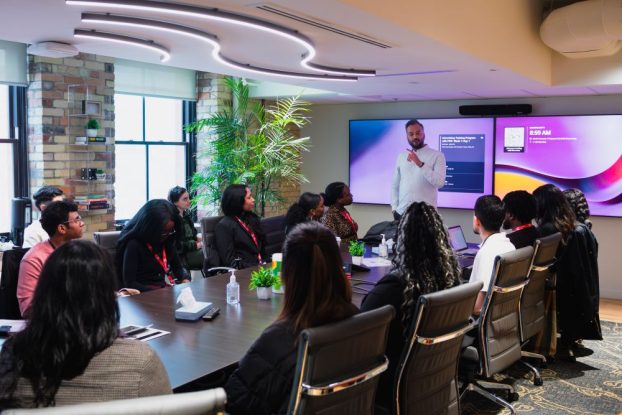When you ask Aldo Cundari, Chairman and CEO of Toronto-based Cundari Group, what he believes sets his agency apart from most of his competitors, his answer is instant and twofold: a proven ability to work as strategic partners with clients and a truly integrated, unbiassed use of the full spectrum of marketing disciplines.
‘We have an enormous bench strength in being strategic partners and thinkers with our clients,’ says Cundari, whose diverse roster of accounts include BMW, Siemens Canada, Electrohome, Bovril and Newbridge. ‘We work well with clients who want our input and we tend not to work well with clients who want to work in a bubble and not look outward. We want to add some tension to the relationship and put our point of view across.’
Cundari’s unique, copyrighted Integrated Planning Process (IPP), developed in-house, is specifically geared to take an integrated approach to creating strategic solutions, melding together all the available marketing tools and disciplines that influence consumers – advertising, interactive, public relations, direct mail, promotions, event marketing, trade shows, packaging, etc. – and then applying them in ways that best influence the decision-making process. ‘IPP helps us determine how we’re going to approach a project strategically and take the steps that assure us that we’re making the right decisions,’ notes Cundari.
Many agencies may call themselves integrated, Cundari claims, when in fact all they have integrated is their floor plate. ‘They might buy a promotional or direct agency who share the same office floor, but the people have no real understanding of how to blend the relative marketing disciplines.’
The true test of integration, he says, is asking whether they have the same clients in each of the separate marketing areas. ‘If they don’t, it means they are basically a direct or promotional agency who is not looking out for the best interests of the client across all disciplines. For us, it doesn’t matter what discipline takes the lead. It’s more a question of: are we considering all of the possibilities or not?’
The Cundari Group’s philosophy is clear-cut: ‘We strongly believe that our clients will always be the keepers of the brand. But agencies should always know more about their consumers.
‘We have a very specific mandate about what we bring to the table and how we rationalize our choices,’ Cundari continues. ‘Our process involves understanding the consumer, affecting the consumer, generating a gut reaction, and then using the appropriate media disciplines at the best place to influence the decision-making process. For example, we might recommend clients not to do general advertising when we know they’ll get a better response at POP, or vice-versa.’
Because Cundari’s staff have grown up understanding why, how and when to do a promotion, or a direct mail campaign, or an ad campaign, it has evolved into an intuitive, almost automatic, process for them, adds Rob Worling, Executive Vice-President, Creative Director.
‘Historically, we have never seen advertising as a separate compartment. We don’t see departmental boundaries or fight over clients’ budgets coming in the door.’
A case in point: after BMW hired Cundari for a general advertising campaign, they gradually began to see the benefit of using a single, integrated agency. After three years of double-digit growth, Cundari now handles all of BMW’s work in financial services, motorcycles, dealer associations, direct, promotional, event, etc.
‘Because the BMW material has the same look, purpose and mandate in the marketplace, it looks as if four to five times as many dollars are being spent against the marketing efforts,’ says Cundari. ‘Yet it all comes from one agency, not 10 different agencies.’
Last year’s highly successful BMW Comparison Drive program, to be repeated again this year, illustrates Cundari’s integrated, consumer-focussed approach. ‘We found out that the majority of BMW users use the Web, so instead of using advertising to induce them to test drive the cars, we created a direct mail campaign personally inviting them to register for an appointment on the Web and participate in a weekend-long event,’ says Worling.
Because the prospects, who tend to be busy executives, were known to be increasingly melding their personal and business lifestyles, the test drive program was seen as a virtual business-to-business project.
‘Business to business works beautifully through direct,’ says Michael Lang, Executive Vice-President and Creative Director. ‘It’s a really good example of using a discipline that other agencies may never use. The key is knowing the replaced consumer with customer so we can focus on their habits and the way they communicate. We knew that if we got the prospects to sit in the BMW and test drive it, they’d probably buy it. As it turned out, we oversold the program.’
Although traditions are rapidly changing in advertising, Cundari believes his agency has always kept one step ahead. ‘More agencies are now looking for single versus multiple sources of revenue. Senior managers of large, global corporate ad agencies are evolving from the integrated, below-the-line side rather than the advertising side. For years, people didn’t believe in our integrated approach. But today, what I’ve been preaching for the last 10-15 years is now becoming the dominant trend.’
The revolutionary influence of the Internet, for example, is extending not only to marketing programs but to how the advertising business is conducted day-to-day, melting traditional structures, both internally and externally.
Cundari recently received a phone call from a software company executive in Montreal. After exchanging a series of e-mails and voice-mails, Cundari was awarded their North American-wide business. ‘We still haven’t met face-to-face. It’s a good example of how our relationships in the marketing area will change as the technology changes, as boundaries continue to break down.’
Having an integrated, unbiassed ability to think intuitively along any medium also makes it easier to come up with creative ideas, Worling observes. ‘We look at a concept and then ask: when is the best time to influence the consumer? In the case of BMW, the perfect combination was direct mail and the Web. Our research told us when the moment of influence would be highest – and we were proven right.
‘The technology simply frees us up to focus on the things that are most important,’ he adds. ‘You can’t hide behind processes. Although technology and new media are changing our world, creative ideas are still king.’
Cundari Group Ltd.
Aldo Cundari, President, CEO
1315 Lawrence Avenue East
Toronto, Ontario
M3A 3R3
Tel: 416-510-1771
Fax: 416-510-1769
e-mail: aldo_cundari@cundari.com
web: www.cundari.com
Also in this sponsored supplement:
– Using insight to incite consumer behaviour p.SA1
– Due North Communications: Our aim is true p.SA2
– Bates Canada: The importance of having a sense of theatre p.SA3
– Carlson Marketing Group: Building clients’ businesses one relationship at a time p.SA4
– Marshall Fenn Communications: Three disciplines. One Solution p.SA5
– Maritz Canada: Leveraging brands through sales channel performance p.SA8
– War Paint Brand Directions: Marketing is about out-thinking your competition. Isn’t it? p.SA9
– Rapp Collins Communicaide: Where data builds brands p.SA11
– Enterprise Creative Selling: Building a model agency p.SA12























